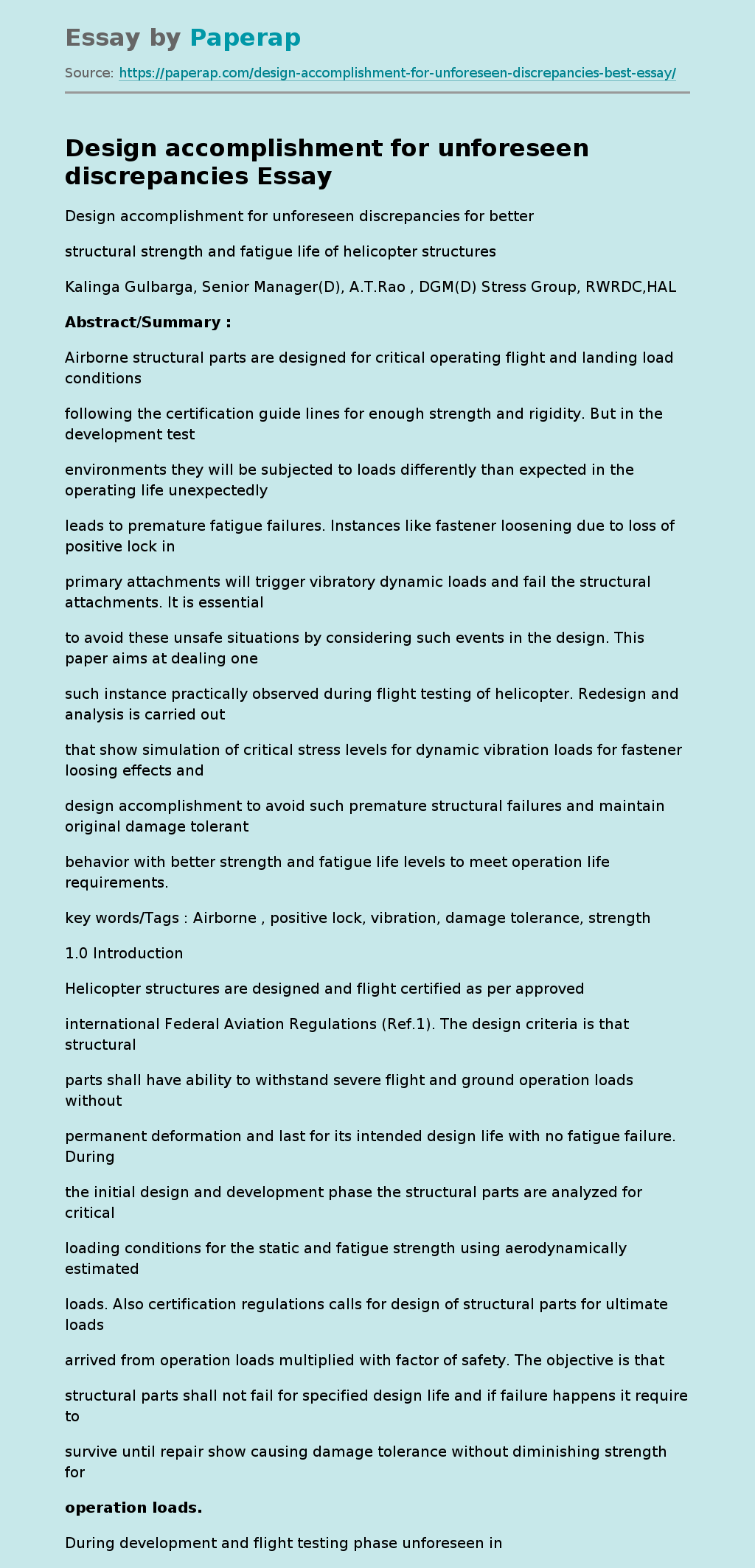Design accomplishment for unforeseen discrepancies
Design accomplishment for unforeseen discrepancies for better
structural strength and fatigue life of helicopter structures
Kalinga Gulbarga, Senior Manager(D), A.T.Rao , DGM(D) Stress Group, RWRDC,HAL
Abstract/Summary :
Airborne structural parts are designed for critical operating flight and landing load conditions
following the certification guide lines for enough strength and rigidity. But in the development test
environments they will be subjected to loads differently than expected in the operating life unexpectedly
leads to premature fatigue failures. Instances like fastener loosening due to loss of positive lock in
primary attachments will trigger vibratory dynamic loads and fail the structural attachments.
It is essential
to avoid these unsafe situations by considering such events in the design. This paper aims at dealing one
such instance practically observed during flight testing of helicopter. Redesign and analysis is carried out
that show simulation of critical stress levels for dynamic vibration loads for fastener loosing effects and
design accomplishment to avoid such premature structural failures and maintain original damage tolerant
behavior with better strength and fatigue life levels to meet operation life requirements.
key words/Tags : Airborne , positive lock, vibration, damage tolerance, strength
1.0 Introduction
Helicopter structures are designed and flight certified as per approved
international Federal Aviation Regulations (Ref.1). The design criteria is that structural
parts shall have ability to withstand severe flight and ground operation loads without
permanent deformation and last for its intended design life with no fatigue failure. During
the initial design and development phase the structural parts are analyzed for critical
loading conditions for the static and fatigue strength using aerodynamically estimated
loads. Also certification regulations calls for design of structural parts for ultimate loads
arrived from operation loads multiplied with factor of safety. The objective is that
structural parts shall not fail for specified design life and if failure happens it require to
survive until repair show causing damage tolerance without diminishing strength for
operation loads.
During development and flight testing phase unforeseen instances may happen
that have potential for structural damages and risk of catastrophic structural failures.
The failure type, location and size are neither genuine nor they are known from
manufacturing process defects. It is important to monitor such instances and consider
them in the initial design of primary structural parts of critical nature and eliminate risk of
catastrophic failures. One such practical event observed during helicopter flight testing
is taken up for study as a case of design accomplishment. It is found in the inspection
after helicopter flight testing, that tail end horizontal control surface structural bracket
near tail rotor got cracked and seen loosened bolt attachment. It could be due to loss of
positive locking at the bolt nut and subsequent high ‘g’ vibration loads at horizontal
control surface could leads to structural bracket failure. Once again the structural
bracket is redesigned with improved strength and attachment redundancy and verified
its ability to sustain vibration fatigue loads apart from its regular operation flight load
support capability.
2.0 Horizontal control surface attachment
Horizontal control surface is an inverted aerofoil which contributes helicopter
stability along the pitching axes. It’s attachment is designed to withstand for maximum
vertical load of Push forward flight maneuver. The details of the horizontal control
surface attachment is shown in the Fig.1.
The machined bracket is used to attach horizontal control surface laterally to the end
of helicopter tail boom using quarter inch bolts. This horizontal control surface is
assembled with vertical control surface for helicopter yawing stability. The total
assembly will act as cantilever and transfers the span wise and chord wise
aerodynamic pressure loads of horizontal and vertical surfaces to the helicopter tail
boom structure through machined bracket. The vibratory load magnitudes if any due to
stiffness loss will also transfer to the tail boom structure.
Fig.1 Horizontal control surface attachment details
Originally the machined bracket is stress analyzed for the critical Push forward flight
loads considering optimized attachments with quarter inch tension bolts. In the
helicopter ground run flight testing the bracket was subjected to vibratory dynamic loads
(Fx,Fy,FZ) which are entirely different from design analysis load of Push forward flight
load case. The load path and magnitudes got changed due to disengagement of tension
bolt and resulted in crack initiation on top flange corner stressed region of machined
bracket. The cracked location and the loosened bolt is shown in Fig.2.
The cracked bracket is replaced with newly redesigned bracket which is designed and
analyzed to sustain vibratory fatigue loads from unexpected instances like nut
disengagement in the operation .
Fig.2 Detailed view of machined bracket attachment showing failure
3.0 Vibratory fatigue loads :
As per regulations it is mandatory to monitor helicopter vibration during flight testing to
track the vibration ‘g’ levels are minimum . The vibration ‘g’ magnitudes in x, y and z
directions captured in the flight testing of bolt loosing instance is shown in the Fig.3
below. The peak vibratory load magnitudes are observed at horizontal and vertical
control surfaces in all x, y and z directions.
The estimated dynamic load magnitudes at horizontal control surface are Fx = 230 N,
Fy = 140N, Fz = 340 N and at vertical control surface are Fx = 260 N, Fy =280N, Fz
=252N. The bracket is redesigned considering these dynamic loads and verified for
fatigue life.
‘g’ Loads at Horizontal control surface ‘g’ Loads at Vertical control
Design accomplishment for unforeseen discrepancies. (2019, Dec 06). Retrieved from https://paperap.com/design-accomplishment-for-unforeseen-discrepancies-best-essay/
